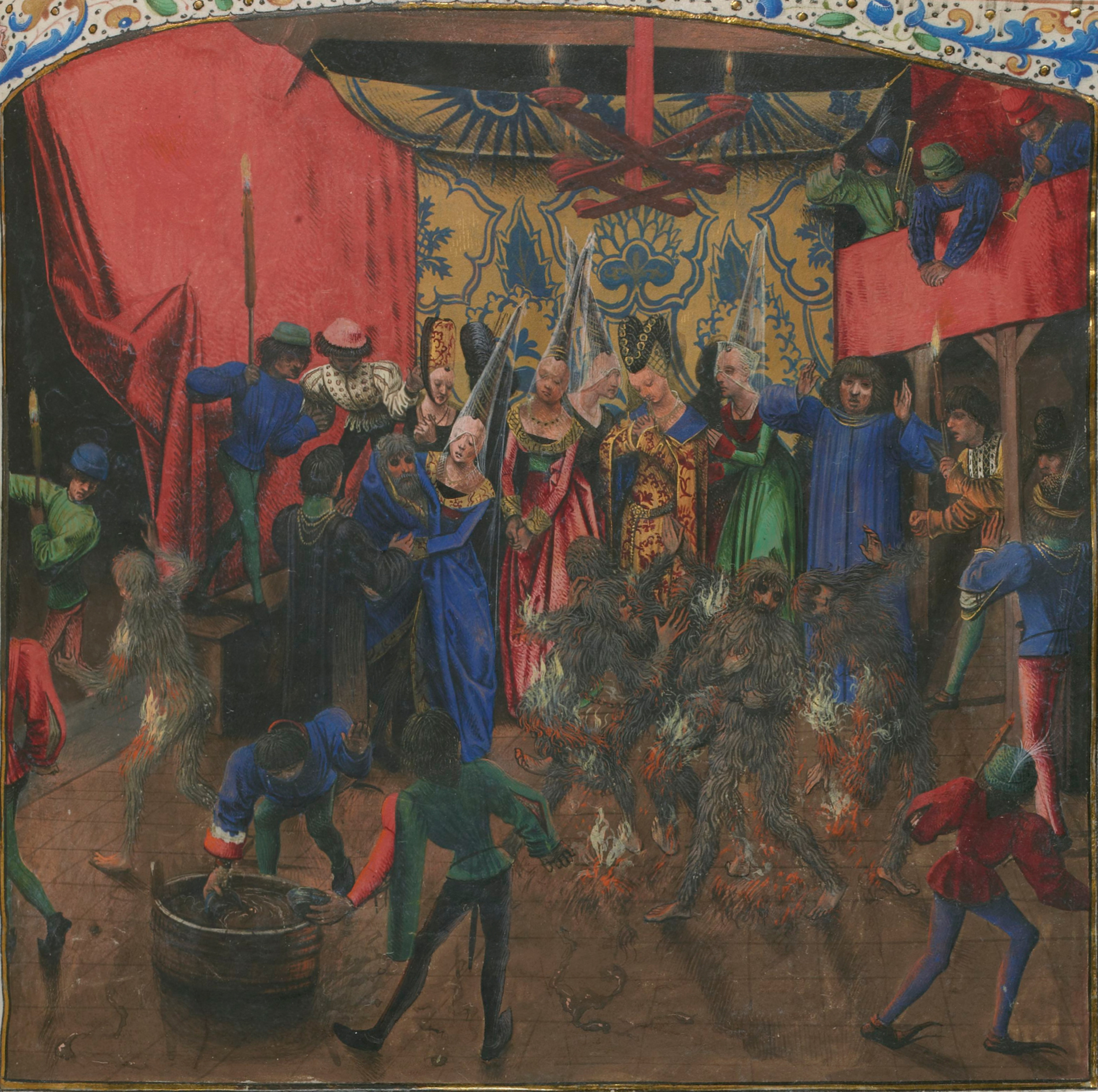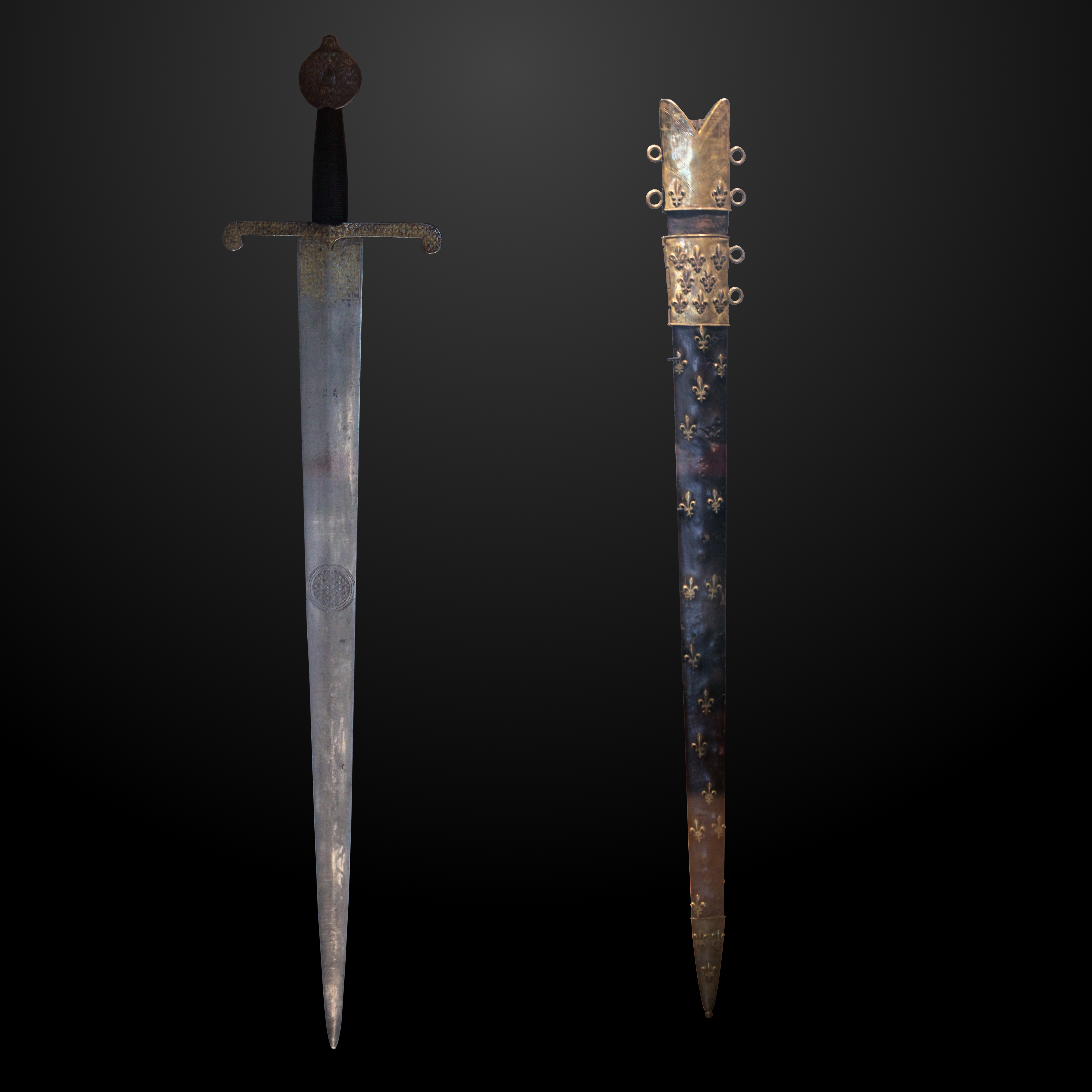|
Battle Of Pontvallain
The Battle of Pontvallain, part of the Hundred Years' War, took place in the Sarthe region of north-west France on 4 December 1370, when a French army under Bertrand du Guesclin heavily defeated an English force which had broken away from an army commanded by Sir Robert Knolles. The French numbered 5,200 men, and the English force was approximately the same size. The English had plundered and burnt their way across northern France from Calais to Paris. With winter coming, the English commanders fell out and divided their army into four. The battle consisted of two separate engagements: one at Pontvallain where, after a forced march, which continued overnight, Guesclin, the newly appointed constable of France, surprised a major part of the English force, and wiped it out. In a coordinated attack, Guesclin's subordinate, Louis de Sancerre, caught a smaller English force the same day, at the nearby town of Vaas, also wiping it out. The two are sometimes named as separate ... [...More Info...] [...Related Items...] OR: [Wikipedia] [Google] [Baidu] |
Froissart's Chronicles
Froissart's ''Chronicles'' (or ''Chroniques'') are a prose history of the Hundred Years' War written in the 14th century by Jean Froissart. The ''Chronicles'' open with the events leading up to the deposition of Edward II in 1326, and cover the period up to 1400, recounting events in western Europe, mainly in England, France, Scotland, the Low Countries and the Iberian Peninsula, although at times also mentioning other countries and regions such as Italy, Germany, Ireland, the Balkans, Cyprus, Turkey and North Africa. For centuries the ''Chronicles'' have been recognized as the chief expression of the chivalric culture of 14th-century England and France. Froissart's work is perceived as being of vital importance to informed understandings of the European 14th century, particularly of the Hundred Years' War. But modern historians also recognize that the ''Chronicles'' have many shortcomings as a historical source: they contain erroneous dates, have misplaced geography, give inac ... [...More Info...] [...Related Items...] OR: [Wikipedia] [Google] [Baidu] |
Louis De Sancerre
Louis de Sancerre (1341 or 1342 – 6 February 1402; aged 60-61) was a Marshal of France and Constable of France during the Hundred Years' War. Early life Sancerre was born as the second son of count Louis II de Sancerre and Béatrix de Roucy. His father was killed at the battle of Crécy in 1346. After the death of his father King Philip VI of France ordered him to be educated together with the children of the Duke of Normandy. Sancerre had his first experience in war during the Siege of Melun in 1359, where he gained the notice of Bertrand du Guesclin. Service under Charles V When Charles V of France became King, Sancerre served in the conquest of Guyenne. The King made him a Marshal of France on 20 June 1368 with the order to protect Paris. In 1369 Sancerre surprised and forced the Earl of Pembroke to retreat to Puyrenon. He aided du Guesclin in winning the Battle of Pontvallain. During the next years, Sancerre fought the English in the Limousin, Languedoc and Guyen ... [...More Info...] [...Related Items...] OR: [Wikipedia] [Google] [Baidu] |
Battle Of Poitiers
The Battle of Poitiers was fought on 19September 1356 between a French army commanded by King JohnII and an Anglo- Gascon force under Edward, the Black Prince, during the Hundred Years' War. It took place in western France, south of Poitiers, when approximately 14,000 to 16,000 French attacked a strong defensive position held by 6,000 Anglo-Gascons. Nineteen years after the start of the war the Black Prince, the eldest son and heir of the English King, set out on a major campaign in south-west France. His army marched from Bergerac to the River Loire, which they were unable to cross. John gathered a large and unusually mobile army and pursued the Anglo-Gascons, whom he brought to battle. The Anglo-Gascons established a strong defensive position near Poitiers and after unsuccessful negotiations were attacked. The first French assault included two units of heavily armoured cavalry, a strong force of crossbowmen and many infantry and dismounted men-at-arms. They were driv ... [...More Info...] [...Related Items...] OR: [Wikipedia] [Google] [Baidu] |
Isabella Of France
Isabella of France ( – 22 August 1358), sometimes described as the She-Wolf of France (), was Queen of England as the wife of King Edward II, and regent of England from 1327 until 1330. She was the youngest surviving child and only surviving daughter of Philip IV of France and Joan I of Navarre. Isabella was notable in her lifetime for her diplomatic skills, intelligence, and beauty. She overthrew her husband, becoming a "femme fatale" figure in plays and literature over the years, usually portrayed as a beautiful but cruel and manipulative figure. Isabella arrived in England at the age of 12 during a period of growing conflict between the king and the powerful baronial factions. Her new husband was notorious for the patronage he lavished on his favourite, Piers Gaveston, but the queen supported Edward during these early years, forming a working relationship with Piers and using her relationship with the French monarchy to bolster her own authority and power. After the death ... [...More Info...] [...Related Items...] OR: [Wikipedia] [Google] [Baidu] |
French Crown
France was ruled by monarchs from the establishment of the Kingdom of West Francia in 843 until the end of the Second French Empire in 1870, with several interruptions. Classical French historiography usually regards Clovis I () as the first king of France, however historians today consider that such a kingdom did not begin until the establishment of West Francia. Titles The kings used the title "King of the Franks" ( la, Rex Francorum) until the late twelfth century; the first to adopt the title of "King of France" (Latin: ''Rex Franciae''; French: ''roi de France'') was Philip II in 1190 (r. 1180–1223), after which the title "King of the Franks" gradually lost ground. However, ''Francorum Rex'' continued to be sometimes used, for example by Louis XII in 1499, by Francis I in 1515, and by Henry II in about 1550; it was also used on coins up to the eighteenth century. During the brief period when the French Constitution of 1791 was in effect (1791–1792) and after ... [...More Info...] [...Related Items...] OR: [Wikipedia] [Google] [Baidu] |
Edward III Of England
Edward III (13 November 1312 – 21 June 1377), also known as Edward of Windsor before his accession, was King of England and Lord of Ireland from January 1327 until his death in 1377. He is noted for his military success and for restoring royal authority after the disastrous and unorthodox reign of his father, Edward II. EdwardIII transformed the Kingdom of England into one of the most formidable military powers in Europe. His fifty-year reign was one of the longest in English history, and saw vital developments in legislation and government, in particular the evolution of the English Parliament, as well as the ravages of the Black Death. He outlived his eldest son, Edward the Black Prince, and the throne passed to his grandson, Richard II. Edward was crowned at age fourteen after his father was deposed by his mother, Isabella of France, and her lover Roger Mortimer. At age seventeen he led a successful coup d'état against Mortimer, the ''de facto'' ruler of the ... [...More Info...] [...Related Items...] OR: [Wikipedia] [Google] [Baidu] |
Philip VI Of France
Philip VI (french: Philippe; 1293 – 22 August 1350), called the Fortunate (french: le Fortuné, link=no) or the Catholic (french: le Catholique, link=no) and of Valois, was the first king of France from the House of Valois, reigning from 1328 until his death in 1350. Philip's reign was dominated by the consequences of a succession dispute. When King Charles IV of France died in 1328, the nearest male relative was his nephew King Edward III of England, but the French nobility preferred Charles's paternal cousin Philip. At first, Edward seemed to accept Philip's succession, but he pressed his claim to the throne of France after a series of disagreements with Philip. The result was the beginning of the Hundred Years' War in 1337. After initial successes at sea, Philip's navy was annihilated at the Battle of Sluys in 1340, ensuring that the war would occur on the continent. The English took another decisive advantage at the Battle of Crécy (1346), while the Black Deat ... [...More Info...] [...Related Items...] OR: [Wikipedia] [Google] [Baidu] |
Vaas, Sarthe
Vaas () is a commune in the Sarthe department in the region of Pays de la Loire in north-western France. Population See also *Communes of the Sarthe department The following is a list of the 354 communes of the Sarthe department of France. The communes cooperate in the following intercommunalities (as of 2020):Communes of Sarthe Cenomani {{Sarthe-geo-stub ... [...More Info...] [...Related Items...] OR: [Wikipedia] [Google] [Baidu] |
Constable Of France
The Constable of France (french: Connétable de France, from Latin for 'count of the stables') was lieutenant to the King of France, the first of the original five Great Officers of the Crown (along with seneschal, chamberlain, butler, and chancellor) and the commander-in-chief of the Royal Army. He was, at least on paper, the highest-ranking member of the French nobility. The was also responsible for military justice and served to regulate the Chivalry. His jurisdiction was called the Constabulary (; or in modern French orthography which sticks closer to the correct pronunciation: ). The office was established by King Philip I in 1060 AD, with Alberic becoming the first Constable. The office was abolished in 1627, with an edict, by Cardinal Richelieu, upon the death of , in order to strengthen the immediate authority of the King over his army. The position was officially replaced by the purely ceremonial title "Dean of Marshals" (), who was in fact the most senior " ... [...More Info...] [...Related Items...] OR: [Wikipedia] [Google] [Baidu] |
Calais
Calais ( , , traditionally , ) is a port city in the Pas-de-Calais department, of which it is a subprefecture. Although Calais is by far the largest city in Pas-de-Calais, the department's prefecture is its third-largest city of Arras. The population of the city proper is 72,929; that of the urban area is 149,673 (2018).Comparateur de territoire: Aire d'attraction des villes 2020 de Calais (073), Commune de Calais (62193) INSEE Calais overlooks the Strait of Dover, the narrowest point in the |






